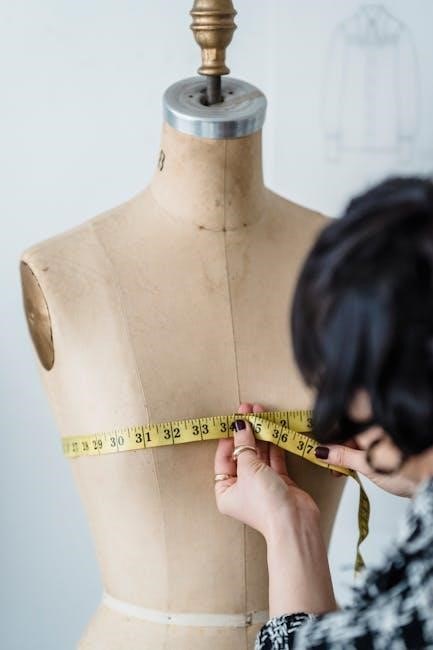size guide for belts
Summary
Discover your ideal belt size effortlessly with our easy-to-use guide. Covers all sizes and styles. Get the perfect fit today!

Belt size guides ensure a perfect fit, blending functionality and style. Proper sizing avoids discomfort and wardrobe mishaps, offering a comprehensive resource for precise measurements and informed selections.
Importance of Proper Belt Sizing
Proper belt sizing is essential for both comfort and functionality. A well-fitted belt ensures trousers or pants stay securely in place, preventing wardrobe mishaps like sagging or constant adjustments. It also distributes weight evenly, reducing discomfort during physical activity. A correctly sized belt enhances the overall appearance of an outfit, creating a polished and put-together look. Additionally, it prevents damage to the belt itself, as ill-fitting belts may stretch or break prematurely. Proper sizing also supports personal confidence, allowing individuals to focus on their daily activities without distractions. By understanding and implementing accurate belt sizing, users can enjoy a seamless combination of style, comfort, and practicality in their everyday attire.

Common Challenges in Belt Sizing
Accurate belt sizing presents several challenges, often leading to poor fits and discomfort. One major issue is the lack of standardization across brands, with sizes varying significantly between manufacturers. This inconsistency makes it difficult for consumers to rely on their usual size, increasing the likelihood of incorrect purchases. Additionally, individuals may struggle with measuring techniques, as improper waist measurement methods can lead to inaccurate size selection. Weight fluctuations and changes in body shape further complicate the process, requiring frequent belt size adjustments. Materials also play a role, as belts made from stretchy or rigid materials may fit differently over time. These challenges highlight the need for a reliable size guide to navigate the complexities of finding the perfect belt fit.
Objective of the Guide
The primary goal of this belt size guide is to provide a clear, comprehensive resource for selecting the ideal belt size. By addressing common challenges and offering straightforward measurement techniques, the guide aims to eliminate the guesswork often associated with belt sizing. Whether you’re shopping for a casual, formal, or specialty belt, this guide ensures a precise fit every time. It covers various factors influencing belt size, such as weight fluctuations, material stretch, and clothing fit, to help users make informed decisions. The guide also includes tips for care and maintenance, extending the life of your belt. By understanding proper sizing and care, you can enhance both comfort and style, ensuring your belt serves as both a functional accessory and a fashionable statement.

Understanding Belt Measurements
Understanding belt measurements is key to selecting the right size. Belts are typically measured from the buckle end to the farthest hole, with sizes ranging from 28 to 44 inches. Accurate waist measurement ensures the best fit.
Standard Belt Size Charts
Standard belt size charts provide a clear reference for selecting the right belt size. Typically measured in inches or centimeters, these charts categorize sizes from small to extra-large. Sizes generally range from 28 to 44 inches for men and 24 to 36 inches for women, ensuring a universal fit. The charts often include numerical sizing, which corresponds to the length of the belt from the buckle to the farthest hole. This system helps maintain consistency across brands, making it easier to choose the correct size. By following these charts, individuals can ensure their belts are neither too tight nor too loose, promoting comfort and style. Accurate sizing is crucial for both functionality and aesthetics, making standard belt size charts an essential tool for shoppers. These charts are widely available online and in stores, offering a reliable guide for belt selection.

How to Measure Your Waist for a Belt
Measuring your waist accurately is key to finding the perfect belt size. Use a flexible tape measure, wrapping it around your natural waistline, typically just above the belly button. Ensure the tape is snug but not tight, and note the measurement in inches or centimeters. If purchasing jeans, measure around the top of the waistband for an accurate fit. For belts, add 1-2 inches to your waist measurement to account for buckle and hole spacing. This ensures the belt fastens comfortably without being too tight. Proper measurement avoids the need for adjustments and guarantees a flattering fit. Remember, belt sizes can vary between brands, so always refer to the specific size chart provided. Taking precise measurements is the first step toward selecting a belt that complements your wardrobe and personal style effortlessly. Accurate sizing ensures both comfort and functionality, making your belt a reliable accessory for years to come.
Converting Measurements to Belt Sizes
Converting waist measurements to belt sizes is straightforward once you understand the relationship between the two. Most belt sizes are based on waist measurements, with a general rule of adding 1-2 inches to your waist size for the belt. This accounts for the buckle and the spacing between holes. For example, a 32-inch waist typically corresponds to a 34-inch belt. Use a flexible tape measure to determine your waist size, then refer to the brand’s size chart for precise conversion. Sizes can vary slightly between brands, so checking the specific chart is essential. Accurate conversion ensures a comfortable fit and proper functionality, avoiding the need for adjustments. By following this method, you can confidently select the right belt size to complement your wardrobe and personal style.

Types of Belts and Their Sizing
Belts come in various styles, each suited for different occasions and preferences. Casual, formal, and specialty belts offer diverse options, ensuring the right fit and aesthetic for any wardrobe need.
Casual Belts
Casual belts are designed for everyday wear, offering versatility and comfort. They are typically made from durable materials like leather, canvas, or synthetic fabrics, ensuring both practicality and style. These belts often feature simple, understated designs that complement jeans, shorts, and casual trousers. One of the key benefits of casual belts is their ease of use; they usually have straightforward buckles that are easy to fasten and adjust. Additionally, casual belts are available in a wide range of colors and finishes, allowing users to match them with various outfits seamlessly. The sizing for casual belts generally follows standard measurement charts, ensuring a snug yet comfortable fit. Whether you’re heading to a park or running errands, a well-chosen casual belt can elevate your look while providing the necessary support and functionality.
Formal Belts
Formal belts are crafted from premium materials like genuine leather, offering a sleek and sophisticated appearance. Designed to complement suits, dress pants, and formal attire, they feature elegant, minimalistic designs with smaller, refined buckles. The buckle’s finish, such as silver or gold, can be coordinated with other accessories for a polished look. Proper sizing is essential for formal belts to ensure a snug, secure fit that enhances the overall professional aesthetic. Using a size guide, formal belts are typically measured from the buckle to the farthest hole, ensuring the right length for a tailored appearance. The choice of material, often high-quality leather, ensures durability and a timeless appeal, while the belt’s thickness is usually thinner to lie flat and maintain a streamlined look. Whether opting for classic colors like black or brown, or unique finishes, a formal belt is a crucial accessory that complements formal wear effectively, ensuring both functionality and style.
Specialty Belts
Specialty belts cater to unique needs and preferences, offering functionality and style tailored to specific lifestyles. Ratchet belts, for instance, feature adjustable mechanisms without holes, providing precise fit customization. Western belts often boast decorative buckles and intricate designs, ideal for bold fashion statements. Utility belts are designed for practicality, with multiple compartments and durable materials for outdoor or work environments. Motorcycle belts are built for durability, often with metal studs or embroidery, to withstand rough use. These belts may require specific sizing considerations, as their materials or mechanisms differ from standard belts. Whether for fashion, function, or niche activities, specialty belts offer versatility and personalization. Sizing guides for these belts may include additional measurements or adjustments to ensure the perfect fit, making them a practical and stylish choice for those with particular preferences or requirements. Their unique designs and features set them apart from casual or formal options.

Factors Influencing Belt Size
Belt size is influenced by weight changes, material flexibility, and clothing fit. These factors impact measurements and comfort, ensuring the right balance between style and functionality in daily wear.
Weight Fluctuations
Weight changes significantly affect belt size, as even small fluctuations can alter waist measurements. Gaining or losing weight impacts the fit, potentially requiring a different belt size for comfort and functionality.
Using adjustable or flexible belts can help accommodate minor changes. However, significant weight changes may necessitate re-measuring to ensure the belt fits properly.
Regular monitoring of waist size is essential to maintain the right fit and prevent issues like tightness or looseness.
Belts with stretchy materials or adjustable buckles offer versatility for varying weights.
Ultimately, weight fluctuations highlight the importance of accurate measurements and flexible belt options for long-term comfort and reliability.
Belt Material and Stretch
Belt material and its ability to stretch play a crucial role in sizing accuracy. Different materials, such as leather, fabric, or synthetic options, vary in elasticity and breathability.
Leather belts, for instance, can stretch slightly over time, providing a more tailored fit, while non-stretch materials like nylon require precise measurements.
Understanding the material’s flexibility helps in selecting the right size, ensuring comfort and durability.
Additionally, some belts feature adjustable buckles or elastic components to accommodate minor size variations.
Considering the material’s stretchiness is essential for achieving a comfortable and secure fit.
Always choose a belt that aligns with your lifestyle and body type for optimal functionality.
Clothing Fit and Style
Clothing fit and personal style significantly influence belt size selection.
For instance, slim-fit pants may require a narrower belt to maintain a streamlined look, while loose-fit styles can accommodate wider belts.
Formal attire often calls for sleeker, thinner belts, whereas casual outfits allow for thicker or novelty designs.
The way clothing fits around the waist also matters; tighter clothing may necessitate a slightly smaller belt size for comfort.
Additionally, layering, such as wearing a jacket or cardigan, can affect belt choice, as the belt must sit comfortably beneath or above these layers.
Ultimately, aligning belt size with clothing fit ensures both functionality and aesthetic appeal, enhancing overall style and confidence.

How to Choose the Right Belt Size
Measure your natural waistline, consider belt material stretch, and personal comfort preferences to select the ideal size. Ensure proper fit for functionality and style.
Considering Waist Size
Your waist size is the primary factor in determining your belt size. Measure around the natural waistline, typically where your pants sit. For an accurate measurement, use a flexible tape measure and keep it level. Ensure you’re not pulling the tape too tight or leaving it too loose. If you’re shopping online, refer to standard size charts that correlate waist measurements with belt sizes. Some brands may vary, so checking their specific sizing is essential. Waist size directly impacts comfort and functionality, as a belt that’s too tight can restrict movement, while one that’s too loose may not secure your pants properly. Always prioritize your waist measurement as the starting point for selecting the right belt size.
Accounting for Belt Thickness
Belt thickness plays a crucial role in ensuring a proper fit. Thicker belts, often made from sturdy materials like leather, may require a slightly larger size to accommodate the added width. Conversely, thinner belts, such as those made from synthetic materials, may fit more snugly. When selecting a belt, consider the thickness of the material, as it can affect how the belt sits in the pant loops and how it feels against your waist. For example, a thick leather belt might need a size adjustment to ensure it doesn’t feel too tight or bulky. Always check the product description for thickness details, as this can influence your size choice. Balancing belt thickness with your waist size ensures both comfort and functionality, making it a key factor in achieving the perfect fit.
Personal Comfort Preferences
Personal comfort preferences are vital when selecting a belt size. Some individuals prefer a snug fit for security, while others opt for a looser style for ease of movement. Belt thickness and material also influence comfort, as thicker or stiffer belts may feel restrictive. Breathability and flexibility are key factors, especially for extended wear. For example, a leather belt might offer a classic look but could feel rigid, whereas a canvas or fabric belt provides a softer, more adaptable fit. Additionally, the buckle design can impact comfort; smaller buckles may be less intrusive, while larger ones might dig into the skin. Considering personal activity levels is crucial—someone with an active lifestyle might prefer a more forgiving material. Ultimately, balancing aesthetics with comfort ensures a belt that enhances both appearance and daily wearability, making it essential to prioritize individual preferences when choosing the ideal size and style.

Care and Maintenance of Belts
Regular maintenance ensures belts last longer. Use protective products to shield materials from damage. Avoid harsh chemicals and direct sunlight to preserve color and integrity. Inspect belts regularly for wear.
Cleaning and Conditioning Leather Belts
Cleaning and conditioning leather belts is essential for maintaining their quality and longevity; Start by gently wiping the belt with a soft cloth to remove dirt and dust. For more thorough cleaning, mix a small amount of mild soap with warm water, dip a cloth into the solution, and lightly scrub the leather. Avoid harsh chemicals or abrasive materials, as they can damage the material. After cleaning, allow the belt to air dry completely. Conditioning is crucial to prevent cracking and dryness. Use a high-quality leather conditioner or oil, applying it evenly with a clean cloth. Let it sit for a few minutes before buffing to ensure a smooth finish. Regular conditioning keeps the leather supple and extends the belt’s lifespan. Store the belt away from direct sunlight to prevent fading and cracking.
Storing Belts Properly
Proper storage is key to maintaining the condition and longevity of your belts. Store them in a cool, dry place, away from direct sunlight, to prevent fading or cracking. Avoid folding or creasing belts, as this can cause permanent damage. For leather belts, roll them gently and place them in a protective box or bag to shield them from dust and moisture. If storing for an extended period, avoid hanging belts by the buckle, as this can stretch the material over time. Instead, lay them flat or coil them loosely. Use separate compartments or dividers to keep belts organized and prevent tangling. For added protection, consider using acid-free tissue paper or cloth to wrap each belt. Regularly inspect stored belts for signs of wear or pests. By following these tips, you can ensure your belts remain in pristine condition for years to come.
Extending the Life of Your Belt
To extend the life of your belt, proper care and maintenance are essential. For leather belts, avoid exposure to harsh chemicals or direct sunlight, as these can cause cracking or fading. Clean your belt with a soft, dry cloth, and condition it occasionally with a leather-specific product. Store belts in a cool, dry place, away from moisture, and avoid folding or creasing them, as this can weaken the material. For fabric or synthetic belts, hand washing with mild soap and allowing them to air dry can help maintain their integrity. Regularly inspect your belt for wear and tear, such as frayed edges or loose buckles, and address these issues promptly. By following these simple care tips, you can ensure your belt remains durable and retains its appearance over time, providing years of reliable service.

Common Mistakes in Belt Sizing
- Ignoring material stretch, leading to overly tight or loose belts.
- Not considering clothing fit and personal comfort preferences.
- Overlooking weight fluctuations and their impact on sizing.
Ignoring Material Stretch
Ignoring material stretch is a common mistake when selecting belt sizes. Different materials, such as leather, canvas, or synthetic, have varying degrees of flexibility. For instance, high-quality leather belts may stretch over time, while synthetic materials tend to retain their shape. Failing to account for this can result in a belt that becomes too loose or remains too tight. To avoid this, consider the material’s natural give when choosing a size. For example, if opting for a leather belt, it’s wise to select a slightly snug fit, as it will likely loosen with use. Conversely, non-stretch materials like nylon or polyester require precise measurements for optimal comfort and functionality. By understanding and accounting for material stretch, you can ensure a more accurate and comfortable fit. This consideration is crucial for both casual and formal belts, as it directly impacts their usability and longevity.
Not Considering Clothing Fit
Not considering clothing fit is another common oversight when selecting belt sizes. The fit of your pants, jeans, or other garments significantly impacts the appropriate belt size. For example, slim-fit or tailored clothing may require a slightly smaller belt to avoid bulkiness, while loose-fit or relaxed styles might need a larger size for proper support. Additionally, the thickness of the belt itself should complement the clothing’s design. A thick belt may overpower delicate or minimalist outfits, while a thin belt might get lost on heavier or more structured clothing. To ensure a seamless look, always consider the style and fit of the clothing the belt will accompany. Checking the belt against your outfit before finalizing the size is a practical step to achieve both functionality and aesthetic harmony. This attention to detail ensures the belt enhances your overall appearance rather than detracting from it;
Overlooking Weight Changes
Overlooking weight changes is a common mistake that can lead to an ill-fitting belt. Weight fluctuations, whether gain or loss, directly affect waist size and, consequently, belt size. Many individuals purchase belts based on their current size without considering potential future changes. This oversight can result in a belt that is too tight or too loose, compromising both comfort and functionality. Regularly reassessing belt size in line with weight changes is essential to maintain a proper fit. Additionally, some materials, like leather, may stretch over time, further complicating the issue. To avoid this, consider purchasing adjustable belts or investing in new belts as needed. Ignoring weight changes can lead to discomfort and a less-than-ideal appearance, making it important to stay mindful of how body changes impact belt sizing. This proactive approach ensures long-term satisfaction and optimal functionality of your belt.
Mastering belt size guides ensures a perfect fit, blending comfort, functionality, and style. By staying informed about weight changes, material stretch, and personal preferences, you can maintain a confident, polished appearance.
Key Takeaways
Proper belt sizing is essential for both functionality and style, ensuring comfort and a polished appearance. Accurate measurements are crucial, as belts are tailored to specific waist sizes. Material stretch and clothing fit significantly impact size selection, while personal comfort preferences guide final choices. Regular belt maintenance extends longevity, and staying mindful of weight fluctuations ensures continued fit. By understanding these factors, individuals can navigate belt size guides confidently, making informed decisions that align with their lifestyle and wardrobe needs. These insights empower users to select belts that enhance their outfits while providing lasting durability and satisfaction.

Final Tips for Perfect Fit
For a flawless belt fit, always prioritize accurate waist measurements and consider belt thickness. Choose materials that align with your comfort preferences, whether leather, canvas, or elastic. Ensure the belt complements your clothing style, adjusting for layers like jackets or heavy fabrics. Regularly check your fit to account for weight changes, and opt for adjustable belts for versatility. To extend belt life, clean and condition leather regularly and store belts properly to prevent bending or warping. Personal comfort should guide your final decision, ensuring the belt feels secure without restricting movement. By combining these practical tips, you can achieve a tailored look and lasting satisfaction with your belt choice.